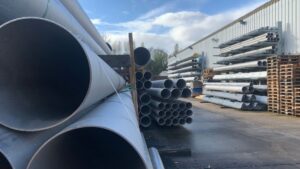Here at Special Piping Materials, we frequently talk to our clients and suppliers about ASTM (American Society for Testing and Materials) Standards as they are an essential part of ensuring the quality of our products. But what do ASTM standards mean? Where did they come from? And what do the different standards mean?
The answers to these questions and much more can be found in this blog!
An overview of ASTM
ASTM international has spent many years researching, examining, testing and defining a wide range of materials for the oil and gas industry.
The properties of the materials in question depend mainly on their chemical make-up and how it reacts and performs in different environments. Design temperatures and pressure as well as methods of manufacture of pipes, fittings, flanges, valves, nuts and bolts are also taken into consideration.
ASTM standards work to define the specific manufacturing processes of an item in a particular material (such as UNS S32760, or ‘super duplex pipe’), as well as other properties such as its exact chemical and mechanical composition, testing methods, dimensions, and even workmanship, finish and appearance.
The ASTM standards are then indicated by their designation which then has to be adhered to through the industry. This ensures both the quality of products and that they are fit for purpose in whatever environment they are in and equipment they are being used for.
So as an example of ‘what do ASTM standards mean’, a seamless pipe could be identified as one of the following: ASTM A312, ASTM A790, ASTM B444.
Interestingly, ASTM International has no specific role or responsibility in requiring or enforcing compliance with its standards. However, the majority of companies in the oil and gas industry refer to them and the standards can become mandatory when they are referenced by an external contract, corporation, or government.
History of ASTM
ASTM International was first formed in 1898 by a group of scientists and engineers, led by US chemist, Charles Dudley. It was first formed in order to combat the frequent rail breaks that were disturbing the railroad industry.
The group originally developed a standard of steel that had to be adhered to if it was going to be used to fabricate train track rails and that is how the standards started.
ASTM currently has more than 30,000 members, there are 12,500 Global ASTM standards I operation globally and more than 140 countries use the standards and participate with them.
What do ASTM standards mean for the different products?
Pipes, fittings, flanges, valves and nuts and bolts all have their own ASTM standards. Special Piping Materials follows these specifications when sourcing and stocking these high-quality products for our discerning clients around the world.
Here is a list of some of them:
Pipes
- A106= This specification covers carbon steel pipe for high-temperature service.
- A790= This specification covers seamless and welded ferritic/austenitic stainless steel pipe
- A333= This specification covers wall seamless and welded carbon and alloy steel pipe intended for use at low temperatures.
- A312= Standard specification for seamless, straight-seam welded, and cold worked welded austenitic stainless steel pipe intended for high-temperature and general corrosive service.
Fittings
- A234= This specification covers wrought carbon steel and alloy steel fittings of seamless and welded construction.
- A815= Standard specification wrought ferritic, ferritic/austenitic, and martensitic stainless steel piping fittings
- A403= Standard specification for wrought austenitic stainless steel piping fittings.
Flanges
- A105= This specification covers standards for forged carbon steel piping components, that is, flanges, fittings, Valves, and similar parts, for use in pressure systems at ambient and higher-temperature service conditions.
- A182= This specification covers forged or rolled alloy and stainless steel pipe flanges, forged fittings, and Valves and parts for high-temperature service.
- A350= This specification covers several grades of carbon and low alloy steel forged or ring-rolled flanges, forged fittings and Valves for low-temperature service.
Valves
- A216= This specification covers carbon steel castings for Valves, flanges, fittings, or other pressure-containing parts for high-temperature service and of quality suitable for assembly with other castings or wrought-steel parts by fusion welding.
- A217= This specification covers steel castings, martensitic stainless steel and alloys steel castings for Valves, flanges, fittings, and other pressure-containing parts intended primarily for high-temperature and corrosive service.
- A352= This specification covers steel castings for Valves, flanges, fittings, and other pressure-containing parts intended primarily for low-temperature service.
- A182= This specification covers forged or rolled alloy and stainless steel pipe flanges, forged fittings, and Valves and parts for high-temperature service.
Bolts and nuts
- A193= This specification covers alloy and stainless steel bolting material for pressure vessels, Valves, flanges, and fittings for high temperature or high pressure service, or other special purpose applications.
- A320= Standard Specification for Alloy-Steel and Stainless Steel Bolting Materials for Low-Temperature Service.
- A194= Standard specification for nuts in many different material types.
